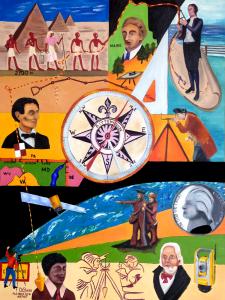Sale on canvas prints! Use code ABCXYZ at checkout for a special discount!

A LONGSTANDING PROFESSION - By: Dean Glorso, Colorado PLS #16109
�I went to the woods because I wished to live deliberately, to front only the essential facts of life. And see if I could not learn what it had to teach. And not, when I came to die, discover that I had not lived� - Henry David Thoreau 1817-1862.
Thoreau is mostly known for his writings while living in a cabin at Walden Pond in Concord, Massachusetts. He traveled often to Maine and worked as a Land Surveyor for about 9 years of his short 44 years of life. As with most �famous� people of our profession, Thoreau didn�t become famous for his particular work as a surveyor, but for his accomplishments of a passion most dear to his heart.
As an artist, I want to illustrate a history of our profession in a �picture�. After all, they say a picture is worth a thousand words. J. B. Guyton, Editor of Side Shots graciously allowed my painting, �A Longstanding Profession�, to be displayed on the cover of this wonderful publication.
In thinking about an art project, I first Googled: �Land Surveyor Artists.� One name that came up was G. K. �Ken� Allred, a past president of the Alberta Land Surveyor Association, Canada. Ken published a remarkable article, �Survey Art � An Interesting Subject�. (I encourage you all to surf the web and read it.) As I read Ken�s article, and did more searching of �Land Surveyor Art� images, I realized no-one had made a painting telling the longstanding history of our profession, thus my reason for doing so. I hope you all enjoy my painting, and read into it, what you wish.
The famous surveyors and surveying objects depicted on the cover of this issue of Side Shots are: Beginning at the top right of the painting, Captain James Cook (1728-1776) standing on his chart of the Newfoundland Coast; Thence continuing left, boustrophedonically (as fields are plowed); to Henry David Thoreau (1817-1862); Thence to the Egyptian Rope Stretchers (2700 B.C.); Thence Edmund Gunter�s Chain (1620); Thence the Surveyor�s Plane Table (prior to 1830); Thence the 30/60 Degree Triangle; Thence George Washington (1732-1799); Thence David Rittenhouse�s Compass (1732-1796); Thence Abraham Lincoln (1809-1864); Thence the Plumb Bob Target; Thence Charles Mason (1728-1786) & Jeremiah Dixon (1733-1779) Line; Thence A GPS Satellite (1st Launch 1978); Thence Meriwether Lewis (1774-1809) & William Clark (1770-1838); Thence Thomas Jefferson (1743-1826) on the US Nickel; Thence Charles Trimble�s Robotic Total Station (2000); Thence Andrew Ellicott (1754-1820), the surveyor who completed the Mason / Dixon Line to the West; Thence The Roman & Greek Surveyors (about 300 A.D.) ; Thence Benjamin Banneker (1732-1796), the surveyor appointed by Washington to layout Washington D.C.; Thence the Brass Plumb Bob (about which a poem I wrote and was published in Side Shots many years ago by Art Hipp), and Thence Terminating at Author Hipp (1925-2007) a Colorado Land Surveying Giant, and Founding Editor of Side Shots Magazine.
The placement of this collage has significance to me as a surveyor/artist. Example: Lincoln is placed North of the Mason / Dixon line in Pennsylvania where he made a very famous speech. Everyone has their own interpretation of a piece of Art. I challenge you, the Surveying viewer to write less than a thousand words to describe your interpretation of this art. Then send your thoughts to Side Shots for possible publication. The surveying community would be interested to know what you think.